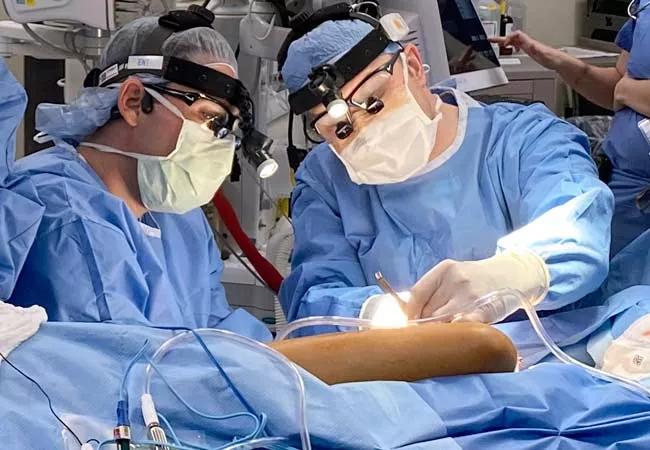Seeking a way to improve outcomes for facial paralysis patients

Cleveland Clinic Head and Neck Institute is conducting a first-of-its-kind human trial investigating whether an intraoperative application of brief electrical stimulation (BES) can improve axonal regeneration in cross-face nerve graft (CFNG) with gracilis free muscle transfer (GFMT).
Advertisement
Cleveland Clinic is a non-profit academic medical center. Advertising on our site helps support our mission. We do not endorse non-Cleveland Clinic products or services. Policy
CFNG is a complex, highly specialized two-stage procedure that is performed in patients with facial paralysis to restore resting facial symmetry and volitional movement. During the first operation, the sural nerve is harvested from the patient’s lower leg. It is then used as a cross-face nerve graft from the unaffected to the affected side of the face. During the second operation, performed six to nine months later, the CFNG, along with the masseteric nerve, is coapted to the gracilis muscle free flap with the goal of creating a dynamic and spontaneous smile.
The success of a CFNG depends on the number of axons that make it through the nerve graft and into the target muscle. The nerve regeneration process is slow: while the axon growth rate averages 1-2mm/day, individual axons grow from the point of injury at different times. When movement is restored, it is usually weaker than the unaffected side. “We are always in search of new strategies to improve the density of axonal regrowth through CFNG, which would ultimately improve our clinical outcomes,” says Peter Ciolek, MD, a facial plastic and reconstructive surgeon at Cleveland Clinic Head and Neck Institute.
Electrical stimulation is commonly used in a variety of clinical applications, such as deep brain stimulation, pain relief and cardiac pacing. In multiple animal studies, BES has been shown to lead to increased rates of axonal regeneration following peripheral nerve repair. This improved initiation of nerve regeneration ultimately leads to greater reinnervation of the target muscle, and thus earlier and improved motor and sensory functional outcomes. “In animal models, BES outperformed other interventions, leading to an increased rate and density of axons following nerve repair,” says Dr. Ciolek.
Advertisement
Human studies of BES to accelerate nerve regeneration have demonstrated its potential to improve outcomes but the studies were small with limited controls. Over 12 years of clinical use, it has a well-established safety profile.
The trial will use the Checkpoint Guardian Nerve Stimulator which is commonly used during surgery to provide electrical stimulation to locate and identify motor nerves.
Supported by an HNI Catalyst Grant, the randomized trial is currently recruiting patients with unilateral facial paralysis with a goal of 20-30 participants at up to three investigational sites. During the first surgery, patients in the treatment group will receive approximately ten minutes of BES delivered to the facial nerve branch following coaptation to the sural nerve graft. This short intervention won’t “add much operative time or cost. Checkpoint units are inexpensive and do not require significant additional training for surgeons familiar with nerve repair techniques,” says Dr. Ciolek, one of four Cleveland Clinic facial plastic surgeons participating in the trial. Also involved with the study are Patrick Byrne, MD, MBA, Chair of the Head & Neck Institute, Michael Fritz, MD, Section Head, Facial Plastic and Microvascular Surgery and Dane Genther, MD, the lead investigator on the study.
The primary outcome measure is myelinated axon count at the distal tip of the cross-face nerve graft, determined by intraoperative biopsy of the nerve during the second-stage gracilis muscle transfer surgery. Secondary measures include clinical smile outcomes, as assessed by clinician-graded eFACE assessment, facial clinimetric evaluation (FaCE), and objective analysis of smile dynamics using machine learning-derived facial landmarking software.
Advertisement
In addition, patients will be evaluated for up to two years following the second-stage surgery to assess functional recovery. Together, the histological samples, functional evaluations and patient-reported outcomes will be used to assess if BES therapy improves nerve regeneration and functional recovery compared to standard treatment alone. “If the trial is successful, we hope to use BES therapy in other types of peripheral nerve surgery within the head and neck, improving treatment and outcomes,” says Dr. Ciolek.
Advertisement
Advertisement

Evidence-based recommendations for balancing cancer control with quality of life

Study shows no negative impact for individuals with better contralateral ear performance

New system brings much-needed clarity and guidance for moderate to advanced-stage disease classifications

Prompt, multidisciplinary care helps navigate the complexities of a rare condition

Looking at short-term outcomes in a high-risk population

Recommendations look to change mindset with CI referrals

Research aims to better understand the tumor immune micorenvironment

Research could help direct care pathways for patients with unexplained swallowing difficulties